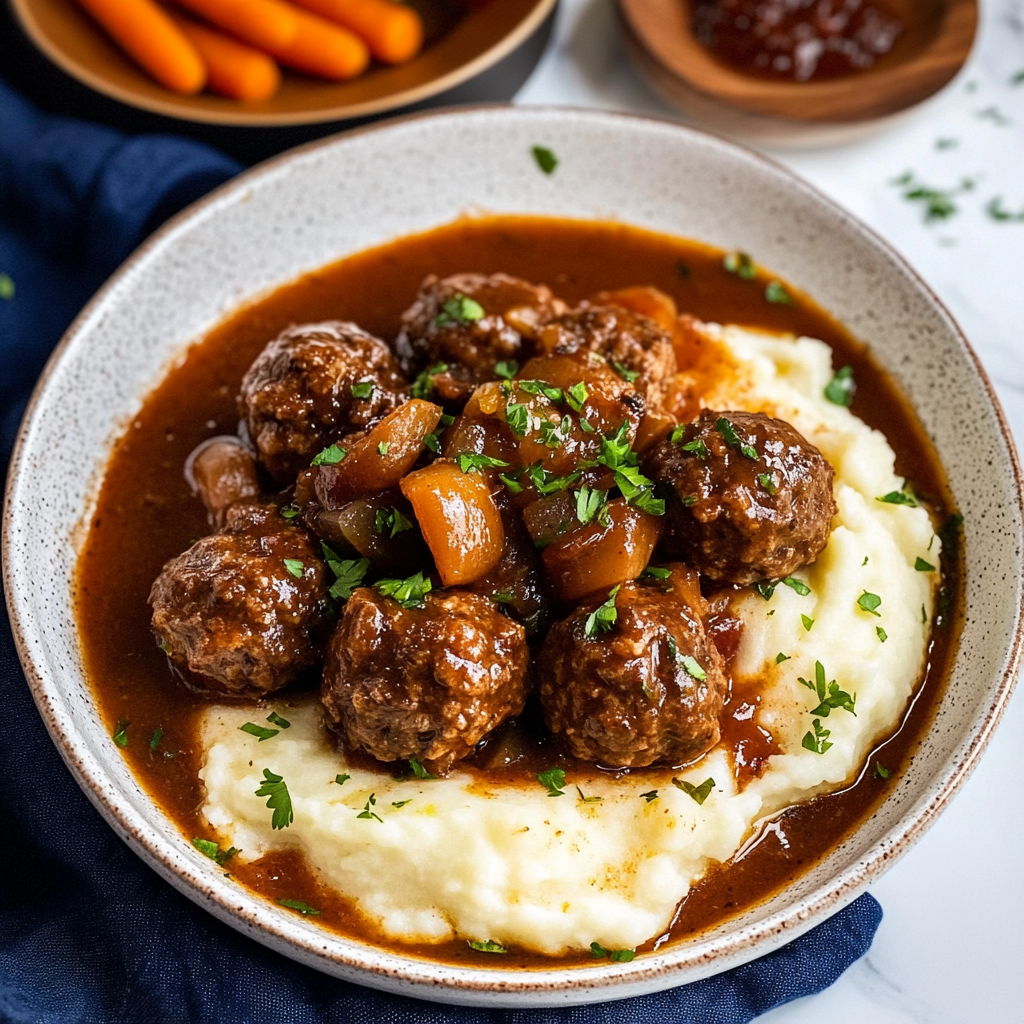Boeuf Bourguignon Meatballs bring all the elegance and depth of classic French cuisine in a comforting, bite-sized format. With tender beef meatballs soaked in a rich red wine sauce, every bite feels like a warm, indulgent hug on a cold evening.
These meatballs are perfect for special dinners or hearty weeknight meals. The red wine sauce is packed with savory vegetables and herbs, and when served over mashed potatoes, it becomes the ultimate comfort dish. It’s simple enough to make, yet fancy enough to impress any guest.
Full Recipe
Ingredients:
-
2 slices white bread
-
½ cup milk
-
½ cup grated Parmesan cheese
-
1 large egg
-
2 tbsp fresh parsley, chopped
-
2 tsp salt
-
1 tsp black pepper
-
2 cloves garlic, minced
-
1 kg (2 lbs) ground beef
For the Sauce:
-
1 onion, finely chopped
-
2 celery stalks, finely chopped
-
3 carrots, peeled and finely chopped
-
250 g (½ lb) mushrooms, thinly sliced
-
6 cloves garlic, minced
-
2 tsp dried herbs (Herbes de Provence or mixed dried herbs)
-
2 bay leaves
-
1 tbsp all-purpose flour
-
2 tbsp tomato paste
-
1 cup beef stock
-
2 cups red wine
Directions:
-
Cut the crusts off the bread and soak it in the milk for 5 minutes. Mash together with Parmesan, egg, parsley, salt, and pepper. Add garlic and ground beef, mix until well combined. Form into meatballs.
-
In a hot pan with oil, brown the meatballs until golden on all sides. Remove and set aside.
-
Deglaze the pan with beef stock, scraping up any browned bits. Set liquid aside.
-
In a large pot, sauté onion, celery, carrots, and mushrooms in oil until softened. Add garlic and dried herbs, cooking for 1 minute. Stir in flour and cook for another minute.
-
Add deglazing liquid, tomato paste, and red wine. Stir well, season with salt and pepper, and bring to a simmer. Cook for 10 minutes.
-
Add meatballs back into the sauce, cover, and simmer for 10 more minutes until meatballs are fully cooked and sauce is rich.
-
Serve over mashed potatoes, garnished with fresh parsley.
Prep Time: 20 minutes
Cooking Time: 30 minutes
Total Time: 50 minutes
Kcal: 315 kcal per serving
Servings: 8 servings
The Origins of Boeuf Bourguignon and Its Evolution into Meatballs
Boeuf Bourguignon is one of the most celebrated dishes in French culinary history. Originating from the Burgundy region of France, this dish was traditionally a peasant meal created to tenderize and elevate inexpensive cuts of beef through slow, wine-based cooking. Over time, it became synonymous with French home cooking, made iconic by chefs like Julia Child. The dish typically involves braising beef with red wine, mushrooms, onions, and herbs, resulting in a rich, savory stew full of depth and comfort.
The transformation of this traditional stew into meatballs is a creative and modern interpretation of the classic. This version retains the heart of Boeuf Bourguignon—the signature flavors, the deep umami, and the luxurious texture—but reimagines it in a more accessible, quicker-cooking form. The meatball format makes it easier to serve, especially for weeknight dinners or elegant entertaining, and allows home cooks to enjoy the essence of the original without the long hours of slow braising.
Why This Dish Works So Well
One of the most compelling aspects of this dish is the way it balances simplicity with sophistication. By forming the beef into meatballs, the preparation becomes quicker and more approachable, yet the sauce retains all the classic depth of flavor thanks to the combination of red wine, aromatic vegetables, and herbs.
What makes this version shine is the texture contrast. The meatballs are juicy and tender on the inside with a lightly crisp sear on the outside, which adds a textural element that you don’t get from a traditional stew. Meanwhile, the sauce develops its complexity through the caramelization of onions, mushrooms, and garlic, and is enriched by the red wine, making it velvety and robust.
It’s a dish that straddles rustic charm and refined taste—perfect for a casual dinner or an elevated meal with guests.
Choosing the Right Wine and Pairings
The red wine is the backbone of this dish, so choosing the right bottle matters. While you don’t need an expensive vintage, you should opt for a dry red wine with good body and acidity—Pinot Noir, Merlot, or a young Cabernet Sauvignon are all excellent choices. These varietals provide the fruity undertones and tannic structure that make the sauce deep and savory.
This dish pairs beautifully with mashed potatoes, which act as a neutral, creamy base to soak up the wine sauce. You can also serve it with buttered egg noodles, crusty bread, or polenta for different textures. A side of lightly sautéed green beans or a simple green salad with vinaigrette balances the richness of the meatballs and sauce.
For a wine pairing at the table, consider serving the same wine you used in the sauce. It complements the flavors naturally and ties the whole meal together beautifully.
Cooking Techniques That Enhance Flavor
There are several techniques in this recipe that maximize flavor without overcomplicating the process. Soaking bread in milk (a classic technique known as a panade) ensures the meatballs stay tender and moist. Using Parmesan in the meat mixture adds umami and enhances the beef’s natural richness.
Deglazing the pan after searing the meatballs is crucial—it captures all the caramelized bits from the bottom, infusing the sauce with even more flavor. Similarly, adding flour to the vegetables before incorporating the liquids gives the sauce a silky, thick consistency, without needing to rely on cream or extra fats.
Each step in the process is thoughtfully included not just for tradition, but to build a dish that is layered and cohesive in taste and texture.
Nutritional Insight and Meal Prep Tips
While Boeuf Bourguignon Meatballs are undeniably rich, they are also balanced. Lean ground beef can be used to keep the fat content in check, and many of the ingredients—carrots, celery, mushrooms, onions—add important vitamins, minerals, and fiber. The dish is also a source of iron and protein, which makes it satisfying and filling.
It stores extremely well, making it ideal for meal prep. The flavors actually improve after a day in the fridge as the sauce continues to develop complexity. You can store the meatballs in an airtight container for up to 3 days in the refrigerator, or freeze them for up to 2 months. Just reheat gently on the stovetop or in the oven, adding a splash of broth or water if the sauce has thickened too much.
Serving and Presentation Tips
When it comes to serving, presentation can take this humble dish to the next level. Spoon the meatballs generously over mashed potatoes, allowing the wine sauce to pool around them. Garnish with freshly chopped parsley or thyme to add a burst of color and freshness.
For a more upscale presentation, consider plating them individually in shallow bowls, perhaps with a ring of mashed potatoes or polenta encircling the meatballs and sauce. This not only looks elegant but also helps contain all that rich goodness.
If serving at a dinner party, you can also offer crusty bread on the side to mop up the sauce. Guests will appreciate both the flavor and the thoughtfulness of the plating.
A Dish for All Occasions
While this recipe feels luxurious, it’s versatile enough to be made for everyday dinners. The ingredients are common pantry staples, and the process can be adapted to fit your schedule. You can prepare the meatballs in advance, freeze them, and simmer them in the sauce just before serving.
Its ability to straddle multiple culinary worlds—comfort food, French-inspired fare, weeknight meal, and elegant dinner—makes it a kitchen essential. Plus, kids and adults alike will enjoy the tender meatballs and rich sauce, making it a crowd-pleasing favorite.
Cultural Appreciation and Modern Reinvention
This dish honors the French tradition while giving it a modern twist. It reflects a broader culinary trend of taking classic comfort foods and adapting them to contemporary tastes and lifestyles. By transforming a slow-braised dish into something more approachable, this recipe becomes both a nod to the past and a statement about the future of home cooking.
Food trends may come and go, but recipes like this endure because they evoke something deeper—a sense of place, memory, and satisfaction. In a world of rushed meals and takeout, taking the time to cook something like Boeuf Bourguignon Meatballs brings joy and connection to the dinner table.
Conclusion
Boeuf Bourguignon Meatballs are more than just a twist on a classic—they represent everything that makes cooking at home worthwhile. They are warm, flavorful, comforting, and elegant all at once. Whether you’re recreating the nostalgia of a French bistro or just looking for a delicious meal to enjoy on a chilly evening, this dish delivers every time.
With thoughtful ingredients, simple yet effective techniques, and deep, satisfying flavor, it’s a dish you’ll return to over and over again. It reminds us that with a little creativity and care, traditional cuisine can be made fresh and exciting for today’s kitchen.






